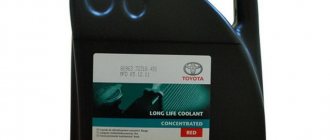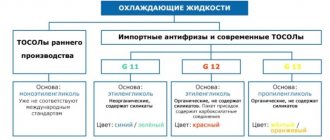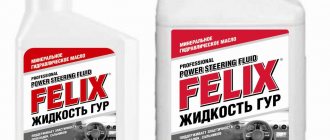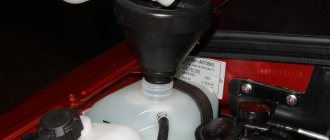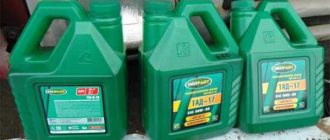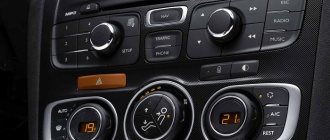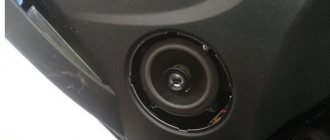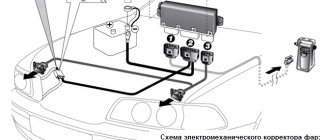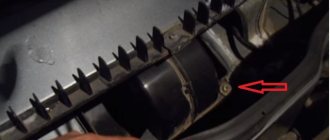There comes a time in the life of a car enthusiast when he begins to worry about the question of what kind of antifreeze is in his car? In this case, we will consider antifreeze for the VAZ Lada Vesta. Sintec antifreeze lux G12, a familiar name for a VAZ owner. This antifreeze is poured into the Lada Vesta from the factory. Let us immediately note that antifreeze for Lada Vesta is of the popular G12 class (TU 2422-047-51140047). This is a positive point, since the cooling system only benefits from this. The coolant that is poured at the factory has an additive package that effectively resists corrosion and greatly extends the service life of the cooling system as a whole. According to the book, it is necessary to change the coolant of the Lada Vesta cooling system every 90,000 km. mileage, or no later than 5 years of driving. There is no need to be afraid of the issue of replacing antifreeze - the service life is decent. Its color is red-orange. It does not contain silicates. The base is ethylene glycol and carboxylate substances. Although there is a downside to this antifreeze, it begins to act only when a source of corrosion has already appeared. Although this feature prevents the appearance of a layer that protects the system from the inside. This prevents the layer from shedding as a result of operation. Result: increased service life, improved heat transfer. Read the article to the end and get many answers on the topic of coolant.
When to change antifreeze
After 90,000 km, or after 5 years, when the time comes to change the fluid, you will not need any special knowledge or tools, because the matter is not too complicated. On the Lada Vesta everything is done quite simply. Therefore, you can safely change it yourself. An independent replacement for a Lada Vesta can be done both on an overpass and in a garage pit. If you are smart, you can climb with a jack and stands under the car. Everyone's conditions and opportunities are different. But in this case, do not forget about safety precautions!
Antifreeze for VAZ Granta
| The table shows the type and color of the required antifreeze for filling into the VAZ Granta, produced from 2011 to 2014. Print |
| Year | Engine | Type | Color | Lifetime | Recommended Manufacturers |
| 2011 | for all | G12+ | red | 5 years | Frostschutzmittel A, VAG, FEBI, Zerex G |
| 2012 | for all | G12++ | red | from 5 to 7 years | Freecor QR, Freecor DSC, Glysantin G 40, FEBI |
| 2013 | for all | G12++ | red | from 5 to 7 years | FEBI, VAG, Castrol Radicool Si OAT |
| 2014 | for all | G12++ | red | from 5 to 7 years | Frostschutzmittel A, FEBI, VAG |
The data in the table is close to those recommended by the VAZ
For diesel and gasoline engines the parameters will be the same! When purchasing, you need to know the shade - the Color and Type of antifreeze allowed for the year of manufacture of your Granta. Select the manufacturer at your discretion. Do not forget - each type of liquid has its own service life. For example, for a VAZ Granta (1st generation) 2011, with any type of engine, a carboxylate class of antifreeze, type G12+ with shades of red, is suitable. The approximate period of the next replacement will be 5 years. If possible, check the selected fluid against the vehicle manufacturer's specifications and service intervals. Important to know Each type of liquid has its own color. There are rare cases when the type is tinted with a different color. The color of red antifreeze can be from purple to light pink (green and yellow have the same principles). Mixing liquids from different manufacturers is possible if their types meet the mixing conditions.
- G11 can be mixed with G11 analogues
- G11 cannot be mixed with G12
- G11 can be mixed G12+
- G11 can be mixed G12++
- G11 can be mixed G13
- G12 can be mixed with G12 analogues
- G12 cannot be mixed with G11
- G12 can be mixed with G12+
- G12 cannot be mixed with G12++
- G12 cannot be mixed with G13
- G12+, G12++ and G13 can be mixed with each other
- Mixing antifreeze with antifreeze (traditional class coolant, type TL) is not allowed. No way!
- Before completely changing the type, rinse the radiator with plain water
- At the end of its service life, the liquid becomes discolored or becomes very dull.
- Antifreeze and antifreeze - very different in quality
- Antifreeze is the trade name for the traditional type (TL) of old-style coolantAdditionally
How to drain antifreeze from Lada Vesta
It is preferable to change the fluid when the car has cooled down. Therefore, if the car engine is still hot, do not rush. Wait until it cools down, as it is very easy to get burned and injure yourself. It is very dangerous! Therefore, performing it on a cold car should not be taken as advice, but as a rule. After all, you can get burned by antifreeze and hot car parts.
- Before replacement and when the car has cooled down, it is necessary to unscrew the cap of the expansion tank. This will relieve excess pressure in the cooling system.
- If your vehicle has an engine guard installed, it must be removed to get to the drain holes. The standard engine protection is secured with thirteen bolts. They are unscrewed with a 10 socket.
- On the left side of the radiator there is a pipe; under it we place a container into which we will drain the coolant. It is better to worry in advance and choose a vessel of optimal size and elastic material. Before carrying out work, it is advisable to minimally clutter the area around you. The container with the drained liquid must be moved and lifted, and therefore it is better to work with durable (rigid) containers. To prevent antifreeze from pouring out at full force, you can screw the cap on the tank. Those who do not experience discomfort can leave the lid open. This will speed up the process.
- Next we need pliers. Loosen the clamp on the pipe and pull it to the side so that you can remove the hose without any obstacles and with ease. We remove the hose, and the liquid successfully drains into the container. If the cap on the tank was screwed on before draining, then when the bulk has drained, you need to remove the cap from the expansion tank back so that the liquid is completely drained. After this, we put the hose on the pipe and install the clamp.
- The next step is draining the antifreeze from the cylinder block. For this step it is necessary to remove the starter. If this is not done, antifreeze will flood it. Before working on electrical parts in a car, be sure to remove the terminal from the battery. Next, using a 10mm wrench, unscrew the three bolts that secure the starter to the clutch housing. We secure the starter using the wire tying method and move it to the side so that it does not interfere with us.
- We unscrew the plug that is located on the cylinder block. A key size 13 is required. This will drain the liquid from the car system as much as possible.
- Screw the plug into place. The landing point has a conical thread, so we don’t need to buy any additional gaskets or rings. The tightening torque according to the ABC book is 25-30 Nm.
What kind of antifreeze is poured into Granta at the factory
Content
Not sure why, but puzzled by the question: “What kind of coolant do they put in the car?”, I did not find any information in the workbook or operational summary that they loaded it at the factory. The recommendation for changing the coolant in the service book is based on 75,000 km (5 years of operation), but there is a reference to the fact that if you fill with coolant-40, it needs to be changed after 2 years. Great, but how do you know what's in there? Useful for exploring the Internet. Pleasant: On the official website of AvtoVAZ, except for the price tags for the car, there is no useful information.
100% carboxylate antifreeze. Refuel new cars at Renault, Nissan, AvtoVAZ factories. Official Renault-Nissan Approval
. This entry was taken from the official website cool-stream.ru, which produces cooling water under the same heading.
Tosol-Sintez supplies its products to the assembly lines of the largest automakers: AvtoVAZ, GM-AvtoVAZ, KAMAZ, MAZ, UAZ, PAZ, IZH-AVTO, KIA, UZ-DAEWOO, approved by BMW, MAN and Volkswagen.
. This entry was taken from the official website ts.ru, which produces coolants under the Felix brand.
Since 2011, SINTEC LUX G12 antifreeze has been used by the largest Russian automobile concern JSC AVTOVAZ as the first refill for LADA cars, and it is also recommended for use during their operation and maintenance.
. This entry was taken from the official website obninskorgsintez.ru, which produces coolants under the SINTEC brand.
It turns out, as always, that at that moment I was in AvtoVAZ, then filled it up? I have a sticker on my expansion tank. antifreeze SINTEC. But antifreezes, depending on the additives added to their additives, are divided into 4 groups: Lobrid (G12 and G13 according to VW specifications)
Lada Grant. I selected and changed the engine and transmission oil!
Carboxylate (G12 and G12 according to VW specification) Hybrid (G 11 specification for VW) Classic (or "inorganic" or "silicate"), which is just referred to by OZh-40, which is mentioned in the service book. Connect which is not better. That's how it works. you need to add coolant. It’s not clear what to add. Change it immediately, just to know exactly what's leaking there.
Lada Granta Liftback 2020, petrol engine 1.6 l, 87 l P., front-wheel drive, manual gearbox. Consumables
Tomorrow her first grant car of 2020 is collecting food. It has one owner, 50,000 miles. Overall, it's sweet, so to speak. I'm writing here because I need advice. Is it worth changing? Because as far as I understand it's out of warranty
READ 2021 Jaguar F-Pace Upgrades Cabin with Pivi Experience, Electrified
Yes, you have to change the burn. I think you can choose quietly by color
Oh, again by color. Well, what kind of nonsense is this anyway?! Do you even believe in your words?! The color of antifreeze is created by a dye that is added to the antifreeze to improve it. Well, for very tight. DO NOT CHOOSE ANTIFREEZE Remember, antifreeze should only be chosen with the permission of the automobile concern! Only But in general, there is nothing better for a grant than its unusual antifreeze. The original is Coolstream NRC for her. Well, wait, it's been working for 4 years. I took it because it certainly has the approval and, apart from this additive, is ideal for these engines.
Thank you very much! I'll take the steep creek
I have a sticker showing the brand of coolant on the expansion tank. The five had a sticker from the factory.
There is also markup for extension
Sintek G 12 Luxury OEM receives grant. understood the week, including color and smell. And yes. they are shamelessly diluting the plant. Unfortunately.
Need to add antifreeze? And don’t remember which one was poured before? Now tell me.
And don't take it to the BBC.
I agree, I also don't like the BBC network (even though we live in different cities). The price tags are not very affordable, the quality is completely lacking.
The price tags on this water and oil are next to nothing, but you need next to nothing.
What happens if you mix several types of antifreeze from different brands? Is it possible to connect them at all? What is the threat? What is the difference between blue antifreeze and reddish one? We will try to cover these and other questions in this article so that the reader has a comprehensive answer and does not engage in “alchemy” when he mocks his entire vehicle.
We say right away that you can combine antifreeze of different brands if certain conditions are met most confidently. In other cases, you are almost guaranteed to throw away the radiator within three years. It will almost always be impossible to return. So think twice before testing your car differently.
Rules for mixing antifreeze
Let's start with the chemistry curriculum. 80% of any cooling water. it is a combination of distilled water and ethylene glycol. This formula is typical for G11 and G12 standards. The remaining 20% (on average). These are additives that characterize a specific antifreeze.
Supplements the main nuance of the composition. They are added to break the destructive power of water and ethylene glycol on the iron components of a vehicle's cooling system, especially the walls and radiator pipes. Roughly speaking, there are only two types of additives: protective. protect pipes and other elements by creating a thin film on the walls of devices. Used in antifreezes and G11 compounds; anti-corrosion. eliminating at least some type of rust during operation or very slowing down such processes. Such additives are typical for G12 and G12.
READ What Oil to Fill in Opel Zafira
There are hybrid additives, separated into a separate composition G13. Chemical elements of the first and second categories are mixed in the correct proportions. That is why this category is considered universal and is suitable for “topping”, but not in all cases.
Antifreeze of different colors was originally intended to work with a specific group of metals. This is not important now, although previously car manufacturers have tried to introduce this gradation by offering recommended "dyes" for compositions. Categories now have the following color: G11. greenish, blue and variations; G12. yellowish-reddish, poisonous orange; G13 purple.
Patterns and colors of antifreeze This is all theory. In practice, many manufacturers paint antifreeze the way they want, because there is no strict standardization. So G11 has a "spread" of blue to magenta, G12 can be greenish, and G13 can be quite yellow. Eventually, confusion ensues and it becomes increasingly difficult for the motorist to navigate the differences in composition and purpose.
What happens when you mix different colors?
Honestly, nothing will happen if you mix warehouses of different manufacturers, although there are certain conditions. Situations are different, including force majeure, so read the composition first. If a greenish G11 interferes with a greenish one, but from a different manufacturer with very similar parameters, the engine will not be affected. Other standards also apply. Only cooler foods of this color and additives can be related.
Now about the “traffic light”. As noted above, the same G11/12/13 can have a wide range of colors. Different colors of antifreeze with the same formula work great together. The main headache for motorists is the purple and yellow G13. Many are afraid that they are completely different, although this is fundamentally false. Let's start with the fact that this antifreeze is universal in nature and has a double portion of additives that coexist without interference. You only get a new color, less.
Can other standards be interfered with?
The situation here is more exciting. If the antifreeze is different in color but one group can be changed, the different products can cause unexpected reactions in the system, only worsening the condition of your radiator and other cooling system components.
READ What Oil to Fill in Chevrolet Lacetti
Is it possible to combine antifreeze from different subgroups? You should know that G11 and G12 have very different additives: the first is intended to create a film, the second. to remove rust. It is almost impossible to control the mixing of active components. Yes, sediment may not settle, but the film will significantly reduce the cooling efficiency. Since then, the greenish antifreeze reduces the diameter of the test tube and other components. Temperature changes as well as cooler properties. A typical “thrombus” may form, which can lead to radiator malfunction.
Mixing antifreeze of different standards. It all depends on the total volume of dilution liquid. If you fill it with half a liter, there will be no consequences. But in the future it is necessary to fill the “native” cooler.
The effect of mixing yellowish and greenish colors
We have already found out whether it is possible to add antifreeze of the same brand and what the consequences are, but is it possible to combine reddish (greenish) and yellowish type antifreeze? And then the consequences will be catastrophic.
Replacing potassium antifreeze with 8 cells without removing engine protection.
Greenish (reddish blue). cooler based on ethylene glycol and distilled water. The yellowish (purple) liquid is composed of propylene glycol, and this is a significant difference. Is it possible to combine these antifreezes? Absolutely not.
Green antifreeze should not be mixed with yellow. Ethylene and propylene are different types of alcohol, although they are monohydric. Another thing is that the 1st is toxic, and in the 2nd case this defect was eliminated. Also add 2 types of additives to G13. The picture we get is this: we don't know how alcohols react together or how serious the consequences are; G13 additives are specially designed for propylene glycol, since no one can tell how they behave in a “foreign” element; no one will give the correct answer about the comparability of antifreeze.
Remember that the universal donor is not G13, but G12. Above it was carefully written which antifreeze can be combined without consequences.
Please read the product contents carefully and never skimp on water cooling. Car repairs will still be more expensive, much less serious. Not the smartest way to save money in your wallet.
The confusion in the colors of antifreeze and antifreeze of any car enthusiast degenerates. During these two years, while the cooler is working and the driver does not care about replacing it, the cheerful manufacturers are setting new standards and variations of their products that play only for advertisers, not for consumers. In addition, coolant also does not accumulate due to its limited shelf life. Try to choose the first manufacturer, find a smart seller who will carefully explain the difference between the tracks. Well, learn to read the ingredient list yourself so you can save on future services.
Source
Where to fill
The plug has been tightened, now we fill it into the system until the expansion tank is full. I recommend pouring in a thin stream to avoid air lock. Don't forget about the starter, put it in place. We filled the system with antifreeze, put the terminal in place, and started the car. While the power unit is operating, we begin to compress all the hoses several times. This approach will ensure good filling of the system and air outlet. We monitor the fluid level, as it may gradually drop. It all depends on the uniform filling of the system when filling liquid and the release of air. Fill to the set level. Do not forget to tighten the plug. Initially, with a cold engine, the lower pipe will be cold for the first minutes after starting, but as the engine warms up, it will begin to warm up and become hot - this means that the system is fully operational, the liquid flows in a large circle - the thermostat has opened. We are waiting for the fan to turn on. Then we checked all the pipes again to make sure they were hot. It’s better to make sure once again that the entire system is full and there are no plugs. We turn off the engine.
When the engine has cooled down, check the fluid level once and, if necessary, add to the required level. That's all, the cooling system has been successfully serviced.
Let's sum it up
Today we are convinced that choosing and replacing antifreeze in LADA Largus is quite simple. The main thing is to follow the manufacturer’s recommendations, comply with the prescribed regulations and beware of counterfeit refrigerants. Do not forget that replacing the coolant must be carried out in strict accordance with the regulations. Use our manual as a guide to action, because we have tried to describe all stages of manipulation in as much detail as possible.
Device Features
Closed pressure cooling system. There is a safety valve in the expansion tank plug. The engine cooling system includes a cabin heating radiator, which is located under the instrument panel.
Filling volume of the engine cooling system:
K4M and K7M (equipped with air conditioning) - 5.45 l;
K4M and K7M (equipment without air conditioning) - 4.5 l.
The temperature at which the thermostat valve begins to open is 89°C.
The temperature of full opening of the thermostat valve is 99 ± 2°C.
The calibration value of the valve in the expansion tank plug is 1.4 bar.
1.6 (16V)
1.6 (8v)
Figure 13-1 — Engine cooling system diagram:
1 - engine; 2 - water pump; 3 - thermostat; 4 — fitting for removing air; 5 — heater radiator; 6 — radiator of the engine cooling system; 7 - expansion tank
PURPOSE AND PRINCIPLE OF OPERATION OF THE COOLING SYSTEM
The efficiency of the cooling system depends on its design and operating conditions. The design of the cooling system is determined by the engine power, the size of the cooling radiator, the type of coolant used and the power of the water pump (coolant circulation pump), the type of fan, thermostat and system pressure. Unfortunately, the cooling system is usually overlooked until problems arise. Proper routine maintenance can prevent such problems from occurring.
The cooling system must allow the engine to warm up to the required operating temperature as quickly as possible and then maintain this temperature. It must operate effectively in an ambient temperature range of -30°F (-35°C) to 110°F (45°C).
The maximum temperature during combustion of the working mixture in the engine periodically soars to a level ranging from 4000°F to 6000°F (from 2200°C to 3000°C). Average combustion chamber temperatures range from 1200°F to 1700°F (650°C to 925°C). Prolonged heating to such high temperatures would cause a decrease in the strength of engine parts, so it is necessary to remove heat from the engine. The cooling system maintains the temperature of the combustion chamber walls in the temperature range that ensures maximum engine efficiency (Fig. 7.1).
Rice.
7.1. Typical combustion temperature of the working mixture and typical temperature of the exhaust gases at the exhaust port
PROBLEMS ARISING IN THE ENGINE AT LOW OPERATING TEMPERATURES
In order for the engine to operate normally, its operating temperature must be above a certain minimum permissible level. If the operating temperature is too low, then there is not enough heat for normal evaporation of the fuel required to obtain the required composition of the fuel-air mixture. As a result, it is necessary to increase fuel consumption in order to create a concentration of its vapors that ensures the flammability of the working mixture. The heavier, less volatile components of gasoline do not evaporate and remain as unburned liquid fuel. In addition to this, part of the working mixture, in contact with the cold walls of the engine, cools down, which leads to incomplete combustion of fuel and the formation of soot.
The combustion of gasoline is a violent oxidative process, which is a chemical reaction of hydrocarbon fuel combining with oxygen contained in the air. This reaction occurs with the release of heat. When five liters of fuel are burned, one liter of water is produced in the form of vapor. Some of this moisture condenses and ends up in the oil pan along with unburned fuel and soot, causing sludge deposits to form. Condensed moisture reacts with unburned hydrocarbons and additives, resulting in the formation of acids: carbonic, sulfuric, nitric, hydrobromic and hydrochloric. These acids are responsible for engine wear caused by internal corrosion and rusting. When the coolant temperature drops below 130°F (55°C), rust immediately appears. At temperatures below 110°F (45°C), water produced during fuel combustion accumulates in the oil. Coolant temperatures below 165°F (65°C) cause rapid wear on the cylinder walls.
To mitigate negative processes in the engine associated with low temperatures and facilitate engine starting in cold weather, most manufacturers offer cylinder block heaters as additional engine equipment. These heaters are connected to a regular electrical network (110 V AC) and the heating element heats the coolant (Fig. 7.2).
Rice. 7.2.
In order to remove the heating element, it is necessary to unscrew the screw that secures it in the technological hole in the wall of the cylinder block (a). The heating element has been removed from the cylinder block. The coolant, heated by the heating element immersed in it, expands and, rising upward, displaces the cold coolant. Due to convective heat exchange, the coolant is heated throughout the engine (b)
PROBLEMS ARISING IN THE ENGINE AT HIGH OPERATING TEMPERATURES
To protect the engine from overheating, its operating temperature should not exceed the maximum permissible temperature. High temperatures cause oil oxidation. Under their influence, the oil dissociates with the formation of coke and drying oils. With prolonged overheating, coke is deposited on the piston rings, clogging them. Lacquered carbon deposits cause jamming of the hydraulic valve lifter plungers. When heated at high temperatures, a decrease in oil viscosity and a decrease in the thickness of the lubricant layer inevitably occur. If the lubricant layer becomes too thin, dry contact between the surfaces of moving parts occurs. At the same time, the friction coefficient increases, which causes a decrease in engine power and accelerated wear of its components.
Overheating the engine is not cheap
Failure of the cooling system is the main cause of engine failure. Auto mechanics are often tormented by nightmares - they dream of how, in a service center, the engine they just repaired is installed in a car whose radiator is clogged. After an engine overhaul or repair, as a rule, the water pump and all hoses must be replaced. Whenever an engine is repaired or replaced, the radiator should also be checked for leaks and blockages. Overheating is the most common cause of engine failure.
COOLING SYSTEM DESIGN
The coolant flows through the engine, absorbing the heat generated within it. It then flows into the radiator, which dissipates the heat to the environment. Coolant continuously circulates through the cooling system, as shown in Fig. 7.3 and 7.4. As coolant passes through the engine, it heats up as much as 15°F (8°C). Then passing through the radiator, it cools down. The rate of pumping coolant can reach 4 liters per minute per horsepower generated by the engine.
Rice. 7.3. Scheme of the flow of coolant through the engine
Rice. 7.4.
The photograph of this cylinder block, from which the plate has been cut, shows the cooling channels surrounding the cylinders. Please note that the coolant washes the cylinders from all sides and also passes through the spaces between them
Engine temperature and exhaust toxicity.
Many areas have vehicle emissions controls in place. Hydrocarbon emissions (HC) are simply unburned fuel. To reduce unburned hydrocarbon emissions and successfully pass emissions testing, ensure that the engine is at normal operating temperature before testing. Automobile manufacturers determine the achievement of "normal operating temperature" by the following criteria:
1.
The upper radiator hose becomes hot and under increased pressure.
2.
The electric cooling fan(s) turn on and off twice.
Make sure the engine is at normal operating temperature before undergoing an emissions test. It is best to drive the vehicle 20 miles (32 km) to ensure that the catalytic converter, oil, and coolant reach normal operating temperature. It is especially important to take care of this in cold weather. Most drivers believe that to warm up the engine, it is enough to let it idle until warm air comes out of the cabin heater. The interior heater removes heat from the coolant. Car manufacturers recommend not allowing the engine to idle for more than 5 minutes, and to warm up the engine, let it idle for one to two minutes, after which, to further warm up, drive the car slowly to increase the oil pressure in the lubrication system.
hot
Coolant flows through the thermostat valve installed at the highest point of the engine into the radiator. The outlet pipe of the cooling system is connected to the upper inlet pipe of the radiator by a hose, which is fixed with clamps. The coolant is cooled in the radiator by the flow of air blowing over it. As it cools, it falls down the radiator and through the lower outlet pipe enters the water pump, which ensures forced circulation of coolant in the engine.
NOTE
In a number of new engine designs, the thermostat is installed at the inlet of the water pump. When cool liquid enters the thermostat, it closes and remains closed until the coolant temperature reaches its opening temperature. Thus, placing a thermostat at the water pump inlet reduces the range of coolant temperature fluctuations, reducing sudden temperature changes that could cause thermal stress in the engine, especially in engines with an aluminum cylinder head and a cast iron block.
The efficiency of heat removal by the cooling system is determined mainly by the efficiency of the radiator. Radiator designs are designed to ensure maximum heat transfer efficiency with minimal dimensions. The air flow around the radiator is enhanced by a belt- or electric-driven cooling fan.
Sales of the Lada Largus car started relatively recently. This car is a joint creation of the Renault-Nissan and AvtoVAZ alliance. A car was made on the VO platform
.
Antifreeze quality check
You should not trust the numbers on the canister; the indicated replacement period on the packaging does not always correspond to reality. Relying on these figures, it is easy to find yourself in a situation where the antifreeze, having exhausted its service life, ceases to perform its functions. And this will inevitably lead to overheating of the power plant, although replacement is not yet necessary. But you can avoid such situations and the troubles that follow.
It is recommended to learn how to independently determine the quality of antifreeze in the cooling system and, based on this check, make a decision about replacing the fluid.
There are about ten ways to determine quality, but not all of them are available to the average car owner. At home, you can check the coolant yourself using three main methods, which are the simplest and do not require financial investment.
| Methods |
Your actions
Test strips. Litmus paper is familiar to many from school in chemistry lessons. They can be purchased at any auto parts store; some manufacturers offer them along with antifreeze as an addition. The test is simple: you need to dip a test strip with a reagent in antifreeze, wait five minutes and evaluate the staining result using the operating instructions. This way you can estimate the time until the next replacement. Visual inspection. Antifreeze that has lost its basic properties can be easily identified by the presence of various foreign impurities (flakes, sediment, sludge, limescale, etc.). The quality can also be judged by the color of the liquid: a cloudy color indicates the need for an early replacement. Boiling. To check the quality, you can boil the antifreeze. It is worth using a small amount of liquid, for example, heating a tablespoon with coolant on a gas burner or stove. If the smell of ammonia (ammonia) is clearly felt when boiling, it means the antifreeze is of low quality or it is a fake. It is better not to use such liquid. It is much more dangerous when a precipitate of copper sulfate granules forms when heated. When using such a liquid in a car, the granules will clog the cooling system channels, which will ultimately lead to overheating of the power unit.